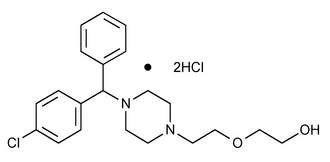Hydroxyzine Hydrochloride
(hye drox' i zeen hye'' droe klor' ide).
Ethanol, 2-[2-[4-[(4-chlorophenyl)phenylmethyl]-1-piperazinyl]ethoxy]-, dihydrochloride, (±)-.
(±)-2-[2-[4-(p-Chloro-
» Hydroxyzine Hydrochloride, contains not less than 98.0 percent and not more than 102.0 percent of C21H27ClN2O2·2HCl, calculated on the dried basis.
Packaging and storage—
Preserve in tight containers.
USP Reference standards  11
11 —
—
USP Hydroxyzine Related Compound A RS
p-Chlorobenzhydrylpiperazine.
p-Chlorobenzhydrylpiperazine.
Identification—
B:
Ultraviolet Absorption  197U
197U —
—
Solution:
10 µg per mL.
Medium:
alcohol.
Absorptivities at 230 nm, calculated on the dried basis, do not differ by more than 3.0%.
C:
To 10 mL of a solution (1 in 400) add 2 drops of nitric acid and 1 mL of silver nitrate TS: a curdy, white precipitate, insoluble in 2 N nitric acid, but soluble in 6 N ammonium hydroxide, separates (presence of chloride).
Loss on drying  731
731 —
Dry it in vacuum at 75
—
Dry it in vacuum at 75 for 3 hours: it loses not more than 5.0% of its weight.
for 3 hours: it loses not more than 5.0% of its weight.
Residue on ignition  281
281 :
not more than 0.5%.
:
not more than 0.5%.
Heavy metals, Method II  231
231 :
0.002%.
:
0.002%.
Chromatographic purity—
Mobile phase, Resolution solution, and Chromatographic system—
Proceed as directed in the Assay.
Standard solution—
Quantitatively dilute the Standard preparation with Mobile phase to obtain a solution having a known concentration of about 1.8 µg per mL of Hydroxyzine Hydrochloride.
Test solution—
Use the Assay stock preparation.
Procedure—
Separately inject equal volumes (about 20 µL) of the Standard solution and the Test solution into the chromatograph, record the chromatograms for a total time of not less than 1.8 times the retention time of the hydroxyzine peak, and measure the response for each peak, except for the main hydroxyzine peak in the chromatogram obtained from the Test solution. Calculate the percentage of each impurity in the specimen taken by the formula:
100(CS / CU)(rU / rS)
in which CS is the concentration, in mg per mL, of USP Hydroxyzine Hydrochloride RS in the Standard solution; CU is the concentration, in mg per mL, of specimen in the Test solution; rU is the peak response of a given impurity in the chromatogram obtained from the Test solution; and rS is the peak response of hydroxyzine in the chromatogram obtained from the Standard solution: not more than 0.3% of any impurity is found, and the sum of all impurities found is not greater than 1.5%.
Assay—
Mobile phase—
Prepare a filtered and degassed mixture of acetonitrile and 0.12 N sulfuric acid (90:10). Make adjustments if necessary (see System Suitability under Chromatography  621
621 ).
).
Standard preparation—
Quantitatively dissolve an accurately weighed quantity of USP Hydroxyzine Hydrochloride RS in Mobile phase to obtain a solution having a known concentration of about 0.3 mg per mL.
Resolution solution—
Dissolve suitable quantities of USP Hydroxyzine Hydrochloride RS and USP Hydroxyzine Related Compound A RS in Mobile phase to obtain a solution containing 3.6 µg of each per mL.
Assay stock preparation—
Transfer an accurately weighed quantity of Hydroxyzine Hydrochloride to a suitable volumetric flask, dissolve in and dilute with Mobile phase to volume to obtain a solution containing a known concentration of about 0.6 mg of Hydroxyzine Hydrochloride per mL, and mix.
Assay preparation—
Quantitatively dilute the Assay stock preparation with Mobile phase to obtain a final known concentration of about 0.3 mg per mL of Hydroxyzine Hydrochloride.
Chromatographic system
(see Chromatography  621
621 )—The liquid chromatograph is equipped with a 230-nm detector and a 4.6-mm × 25-cm column that contains packing L3. The flow rate is about 1.0 mL per minute. Chromatograph the Resolution solution and the Standard preparation, and record the peak responses as directed for Procedure: the resolution, R, between hydroxyzine related compound A and hydroxyzine is not less than 1.5; and the relative standard deviation for replicate injections of the Standard preparation is not more than 2.0%. [note—For identification purposes, the relative retention times are about 0.9 for hydroxyzine related compound A and 1.0 for hydroxyzine. ]
)—The liquid chromatograph is equipped with a 230-nm detector and a 4.6-mm × 25-cm column that contains packing L3. The flow rate is about 1.0 mL per minute. Chromatograph the Resolution solution and the Standard preparation, and record the peak responses as directed for Procedure: the resolution, R, between hydroxyzine related compound A and hydroxyzine is not less than 1.5; and the relative standard deviation for replicate injections of the Standard preparation is not more than 2.0%. [note—For identification purposes, the relative retention times are about 0.9 for hydroxyzine related compound A and 1.0 for hydroxyzine. ]
Procedure—
Separately inject equal volumes (about 20 µL) of the Standard preparation and the Assay preparation into the chromatograph, record the chromatograms for a total time of not less than 1.8 times the retention time of the hydroxyzine peak, and measure the response for the main hydroxyzine peak in the chromatograms. Calculate the percentage of C21H27ClN2O2·2HCl, in the portion of Hydroxyzine Hydrochloride taken by the formula:
100(CS / CU)(rU / rS)
in which CS is the concentration, in mg per mL, of USP Hydroxyzine Hydrochloride RS in the Standard preparation; CU is the concentration, in mg per mL, of Hydroxyzine Hydrochloride in the Assay preparation; and rU and rS are the peak responses of hydroxyzine in the chromatograms obtained from the Assay preparation and the Standard preparation, respectively.
Auxiliary Information—
Please check for your question in the FAQs before contacting USP.
| Topic/Question | Contact | Expert Committee |
|---|---|---|
| Monograph | Ravi Ravichandran, Ph.D.
Principal Scientific Liaison 1-301-816-8330 |
(SM42010) Monographs - Small Molecules 4 |
| Reference Standards | RS Technical Services 1-301-816-8129 rstech@usp.org |
USP35–NF30 Page 3458
Pharmacopeial Forum: Volume No. 32(5) Page 1456

